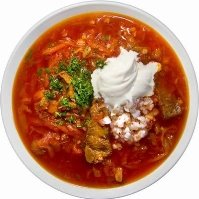Методична розробка уроку з англійської мови на тему: "Традиційна українська національна кухня"

![]()
![]()
ДЕРЖАВНИЙ ПРОФЕСІЙНО-ТЕХНІЧНИЙ НАВЧАЛЬНИЙ ЗАКЛАД
НІКОПОЛЬСЬКИЙ ЦЕНТР ПРОФЕСІЙНОЇ ОСВІТИ
Методична розробка уроку з англійської мови на тему:
"Традиційна українська національна кухня"

Укладач: М.М.Лисенко
2019 р
Тема: Культура харчування.
Підтема: Традиційна українська національна кухня.
Мета: Ознайомити учнів з традиціями української кухні.
Повторити й відпрацювати ЛО теми.
Розвивати навички аудіювання.
Удосконалювати техніку читання.
Формувати навички писемного мовлення.
Продовжувати формувати комунікативні вміння учнів.
Розвивати ерудицію учнів.
Прищеплювати усвідомлення важливості правильного харчування для здоров’я людини.
Обладнання: Підручник , текст для читання (НО1), картки для письмової роботи (НО2), картки з домашнім завданням (НО3), ноутбук та відео проектор, відео ролик
ХІД УРОКУ
І. Підготовка до сприйняття іншомовного мовлення
1. Привітання.
T: Good morning, students! How are you today?
Ps: Good morning, teacher! We are fine, thank you?
T: Who is on duty today? Who is present today?
2. Повідомлення теми та мети уроку.
T: The topic of the lesson today is “Ukrainian traditional cuisine”. So, we are going to speak about Ukrainian traditions concerning food and cooking, and get to know more about the peculiarities of Ukrainian cuisine. By the end of the lesson you should be able to tell us a short account of Ukrainian food.
3. Уведення в іншомовну атмосферу.
Перегляд відео ролику “Ukrainian food” та його обговорення.
T: First, let’s see the video and than discuss it.
4. Перевірка домашнього завдання.
T: Your homework was to prepare your favourite recipe of a typical national Ukrainian dish. Take turns to tell us about your favourite dishes.
P1 – P2 – P3 – P4 -…
II.Основна частина уроку
1. Подання тексту для читання.
1) Етап підготовки до читання. Бесіда з учнями.
T: If you invite your new friends from England or from any other country, you will treat them to our traditional meals. Do you know how they are called in English? So let’s read about Ukrainian traditional dishes.
2) Етап читання та перевірки розуміння змісту тексту. Учні отримують картки (НО1), читають текст та заповнюють таблицю.
НО1:
|
Ukrainian national food and cuisine
Ukrainian national food got a merited renown almost in all places of the world. Different floury dishes (pampushki, galushki, vareniki, korzhi and others), meat dishes (Ukrainian sausages, cold collations, game, birds etc.), vegetable and milk dishes (ryazhenka and sirniki), various drinks of fruit and honey are very popular in Ukraine.
Various porridges - varenikу filled with cottage cheese, potatoes, stewed cabbage and berries in summer - are prevalent in Ukraine too.
Fish dishes have a considerable part in Ukrainian national food assortment from the old times. For example, crucian (carp) baked in sour cream, fish krucheniki, carp stuffed with mushrooms and boiled buckwheat, carp stewed with onion or sour cream, pike perch stuffed with mushrooms and crawfish, and others.
Meat or liver pies are usually cooked for the most solemn occasions. The ceremonial dish was fruit compote - uzvar. Now these dishes are common in every Ukrainian and Russian canteen or restaurant. |
2.Розвиток навичок писемного мовлення
T: Write a short summary about peculiarities of Ukrainian national food. Make up five paragraphs with approximately 3-5 sentences in each on.
Учні отримують картки (НО2) і письмово виконують завдання.
НО2:
|
Introduction |
|
|
Paragraph 1 |
A topic sentence _____________________________________ |
|
Paragraph 2 |
A topic sentence _____________________________________ |
|
Paragraph 3 |
A topic sentence _____________________________________ |
|
Conclusion |
|
3. Відпрацювання лексичного матеріалу
Робота з підручником. Впр. 7 ст.57, впр.3 ст70.
Т: Now let’s read and guess what a Ukrainian specialty each paragraph mentions about.
P1 – P2 – P3 – P4 -…
T: Read the recipe and put the steps below in the correct order.
P1 – P2 – P3 – P4 -…
ІІІ. Заключна частина уроку
1. Домашнє завдання.
Виконати завдання на картках НО3.
НО3:
|
Read the text about the Ukrainian borsch with pampushkas (dumplings). Some sentences have been removed from the text. The task is to fill the gaps with the sentences from the list (A-F). Ukrainian borsch with pampushkas (dumplings).
(3) ____. Put some sour cream curdled together with the finely cut greenery into the plate. (4) ______. Recipe for making pampushkas: take flour, sugar, diluted in warm waster leaven (yeast), some vegetable oil. (5) ___ Grate garlic with salt, add some vegetable oil, boiled water, stir the mixture and pour the resulting sauce over the baked rolls. (6) _____ .
|
2. Підведення підсумків уроку.
Бесіда в режимі T-P1-P2-P3…
T.: What topic did we discuss at the lesson today? What new information have you learned about Ukrainian traditional cuisine? Let’s make the table …
|
Cabbage leaves are used in making cabbage roles (holubtsi) |
|
Cabbage soup (kapustniak) |
||
|
|
||
|
Meat |

![]()
|
Boiled or baked potato |
|
|
|
Traditional Ukrainian food |
|
The favourite dishes made of flour are: dumplings (varenyky) with different types of filling |
|
Dishes made from either fresh or dried fruit: usvar, compote, kysil |
|
Food prepared with milk: soured milk, cottage cheese, brynza (a salty cheese from sheep’s milk) |

![]()
![]()

про публікацію авторської розробки
Додати розробку






